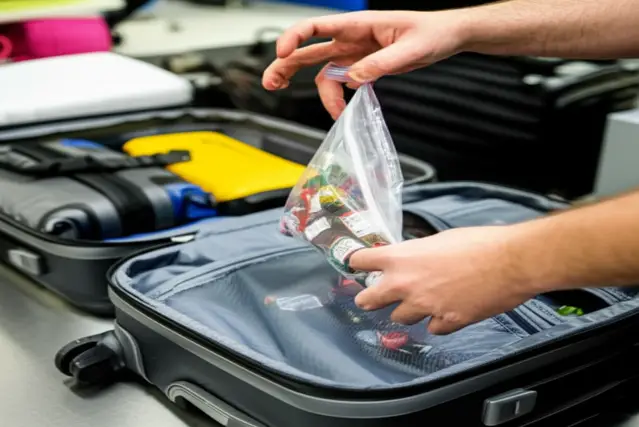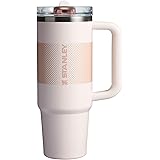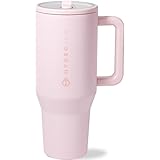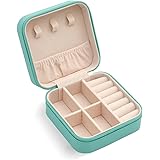Planning to travel and wondering if you can bring those handy little “nips” (miniature alcohol bottles) along for the ride? It’s a question that crosses the minds of many travelers, and the answer isn’t always straightforward. Navigating the world of airline regulations, TSA guidelines, and international travel rules can feel like traversing a turbulent flight itself. But fear not! This comprehensive guide will break down everything you need to know about traveling with nips on a plane in 2025, so you can pack smart and avoid any unwelcome surprises at security or onboard.
Whether you’re looking to enjoy a celebratory drink at your destination or simply prefer to have your favorite spirit on hand, understanding the rules surrounding alcohol on flights is crucial. This guide provides up-to-date information, incorporating current trends, statistics, and the latest regulations to ensure you’re well-informed. Let’s dive into the specifics!
Understanding the Terminology: What Exactly are “Nips”?
Before we delve into the regulations, let’s clarify what we mean by “nips.” In the context of this article, “nips” refer to those small, single-serving bottles of alcohol, typically containing 50ml (1.7 fl oz) or sometimes up to 100ml (3.4 fl oz). They are often found in liquor stores and are a convenient option for those who want a small amount of alcohol without committing to a larger bottle.
These miniature bottles go by various names, including:
- Miniatures
- Mini bottles
- Shooters
- Airplane bottles (though technically, that term can be misleading)
- Travel-sized alcohol
Regardless of what you call them, it’s their size and alcohol content that primarily determine whether you can bring them on a plane.
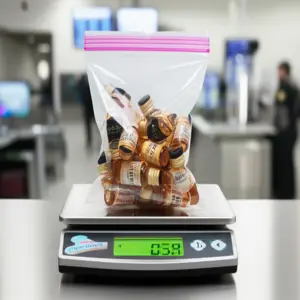
mini liquor bottles
TSA Regulations: The Foundation for In-Flight Alcohol Rules
The Transportation Security Administration (TSA) is the first hurdle for anyone attempting to bring liquids, including alcohol, onto a flight. Their primary concern is safety and security, so their regulations are designed to prevent prohibited items from entering the aircraft cabin. Understanding these rules is paramount.
The 3-1-1 Rule for Carry-On Liquids
The cornerstone of TSA’s carry-on liquid policy is the “3-1-1 rule”:
- 3.4-ounce (100ml) bottle or less: All liquids must be in travel-sized containers that are 3.4 ounces (100 milliliters) or smaller.
- 1 quart-sized, clear, plastic zip-top bag: These bottles must fit comfortably in one quart-sized, clear, plastic zip-top bag.
- 1 bag per passenger: Each passenger is limited to one such bag.
So, can you bring nips on a plane according to TSA? The answer is potentially, yes, if they meet the 3-1-1 rule. If each nip is 3.4 ounces (100ml) or less and fits comfortably within your quart-sized bag, you’re generally good to go, at least as far as TSA is concerned.
Exceptions to the 3-1-1 Rule
There are a few exceptions to the 3-1-1 rule, but they don’t typically apply to nips:
- Medically Necessary Liquids: Medications and medically necessary liquids are exempt from the 3-1-1 rule, but you may need to declare them to a TSA officer.
- Baby Formula and Breast Milk: Similar to medications, baby formula and breast milk are also exempt, but again, you should declare them.
Since nips are unlikely to fall under these exceptions, the 3-1-1 rule is the governing factor for carry-on scenarios.
Alcohol in Checked Baggage: A Different Story
The rules for alcohol in checked baggage are more lenient than those for carry-on items, but they still come with certain restrictions. Here’s the breakdown:
- Alcohol Content: For alcoholic beverages with more than 24% but not more than 70% alcohol by volume (ABV), the amount you can bring is limited to 5 liters (1.3 gallons) per passenger.
- Packaging: The alcohol must be in unopened retail packaging.
- Alcohol Content Above 70% ABV: Alcoholic beverages with more than 70% ABV (140 proof) are prohibited in both carry-on and checked baggage. This is due to their flammability.
Therefore, if your nips are in their original, unopened packaging, have an ABV between 24% and 70%, and you stay within the 5-liter limit, you can pack them in your checked baggage. Keep in mind that exceeding the 5-liter limit can result in confiscation.
TSA and Alcohol Consumption: The Key Distinction
It’s important to note that TSA’s primary focus is on security and safe transport. They are not responsible for enforcing laws related to alcohol consumption. Their job is to ensure that no prohibited items are brought onto the plane. Whether you can actually drink the alcohol you bring onboard is a completely separate issue, governed by airline regulations.
Airline Regulations: The Crucial Next Step
Even if you successfully navigate TSA regulations and bring your nips onto the plane, you’re not necessarily in the clear. Airlines have their own rules regarding alcohol consumption on board, and these rules are often stricter than TSA guidelines.
Federal Aviation Regulations (FARs) on Alcohol
Federal Aviation Regulations (FARs) outline the basic rules regarding alcohol on aircraft. These regulations are broad and give airlines significant leeway in setting their own policies. The key FARs to be aware of include:
- FAR 91.17: Alcohol or drugs. This regulation prohibits crewmembers from performing their duties while under the influence of alcohol or drugs.
- FAR 121.575: Alcoholic beverages. This regulation prohibits serving alcohol to passengers who appear to be intoxicated. More importantly for our discussion, it states that no person may drink any alcoholic beverage aboard an aircraft unless the certificate holder (i.e., the airline) has served that beverage to him or her.
The implications of FAR 121.575 are clear: You are generally prohibited from consuming your own alcohol onboard a commercial flight. The airline must serve the alcohol to you. This regulation is the foundation for most airlines’ policies prohibiting passengers from drinking their own alcohol, including nips, on the plane.
Specific Airline Policies on Alcohol Consumption
While FARs provide a framework, each airline has its own specific policies on alcohol consumption. Here’s a look at the policies of some major airlines (as of 2025):
| Airline | Policy on Consuming Own Alcohol | Notes |
|---|---|---|
| American Airlines | Prohibited | Passengers are only allowed to consume alcohol served by flight attendants. Violators may face penalties. |
| Delta Air Lines | Prohibited | Similar to American Airlines, Delta only allows consumption of alcohol served by their flight attendants. |
| United Airlines | Prohibited | United Airlines has a strict policy against consuming your own alcohol onboard. |
| Southwest Airlines | Prohibited | Southwest enforces a policy against drinking personal alcohol brought onto the plane. |
| JetBlue | Prohibited | JetBlue adheres to the standard policy of only allowing consumption of alcohol served by their crew. |
| Alaska Airlines | Prohibited | Alaska Airlines prohibits the consumption of personally-owned alcohol on board. |
As you can see, the overwhelming majority of airlines prohibit passengers from consuming their own alcohol on board. This includes nips, even if they were legally brought through security. The rationale behind these policies is to control alcohol consumption, prevent disruptive behavior, and ensure the safety and comfort of all passengers.
Consequences of Violating Airline Alcohol Policies
The consequences of violating airline alcohol policies can range from a stern warning to more severe penalties. These can include:
- Verbal Warning: Flight attendants may simply ask you to stop drinking your own alcohol.
- Confiscation: They may confiscate the alcohol from you.
- Written Warning: You may receive a written warning, which could be added to your passenger record.
- Removal from the Flight: In more extreme cases, if you become disruptive or intoxicated, you could be removed from the flight at the next available airport. This can result in being placed on a no-fly list.
- Legal Penalties: You could face legal penalties, including fines or even arrest, depending on the severity of the incident and the local laws of the jurisdiction where the incident occurred.
It’s important to remember that the flight crew has the authority to take action to ensure the safety and security of the flight. Ignoring their instructions can lead to serious consequences.
International Travel: Navigating Global Alcohol Regulations
Traveling internationally adds another layer of complexity to the question of bringing nips on a plane. Not only do you have to contend with TSA and airline regulations, but you also need to be aware of the customs regulations of your destination country and any connecting countries.
Customs Regulations and Duty-Free Allowances
Most countries have regulations regarding the amount of alcohol you can bring into the country duty-free. Exceeding these allowances can result in duties and taxes, or even confiscation of the alcohol. These allowances vary widely from country to country.
Here are some examples of duty-free alcohol allowances for popular destinations (as of 2025; always check the official government website for the most up-to-date information):
| Country | Duty-Free Alcohol Allowance | Notes |
|---|---|---|
| United States | 1 liter of alcohol per person | Travelers who are not U.S. residents are generally allowed the same duty-free exemptions as U.S. residents. |
| Canada | 1.5 liters of wine or 1.14 liters of spirits or 24 x 355 ml cans or bottles of beer or ale. | Must be of legal drinking age in the province/territory of entry. |
| United Kingdom | 42 litres of beer and 18 litres of still wine and 4 litres of spirits and 9 litres of fortified wine (e.g. sherry, port) | These allowances are for travellers arriving from outside the UK. |
| European Union | 1 liter of spirits over 22% ABV; or 2 liters of fortified wine or sparkling wine; and 4 liters of still wine; and 16 liters of beer. | These allowances apply to travel between non-EU countries and the EU. Allowances may differ between EU member states. |
| Australia | 2.25 liters of alcoholic beverages per adult | All alcoholic beverages, including beer, wine, and spirits, are included in this allowance. |
It’s crucial to research the specific customs regulations of your destination country before you travel. Official government websites are the most reliable source of information.
Duty-Free Shopping at Airports
Duty-free shops at airports offer a convenient way to purchase alcohol and other goods without paying local taxes and duties. However, there are a few things to keep in mind:
- Secure Tamper-Evident Bag (STEB): If you purchase alcohol at a duty-free shop and you have a connecting flight, the alcohol will typically be placed in a STEB. This bag is designed to prevent tampering and ensure that the alcohol remains unopened until you reach your final destination. Do not open the bag until you arrive at your final destination country; opening it prematurely could lead to confiscation at your connecting airport.
- Carry-On Restrictions: Even if you purchase alcohol at a duty-free shop, it still needs to comply with the carry-on restrictions of your connecting flights. If the alcohol exceeds the 3.4-ounce (100ml) limit and you don’t have a STEB, it will likely be confiscated at security.
- Destination Country Regulations: Remember that duty-free purchases are still subject to the customs regulations of your destination country. Don’t exceed the duty-free allowance, or you may have to pay duties and taxes.
Carefully consider whether purchasing alcohol at a duty-free shop is worth the risk and potential hassle, especially if you have connecting flights. It might be simpler to purchase alcohol at your final destination.
Specific Country Regulations and Cultural Considerations
In addition to customs regulations, it’s important to be aware of any specific country regulations or cultural considerations regarding alcohol. Some countries have strict laws about public drinking, while others have religious or cultural norms that discourage alcohol consumption. Be respectful of local customs and laws to avoid any misunderstandings or legal issues. For example, many Middle Eastern countries have very strict laws regarding alcohol importation and consumption.
Trends and Statistics in Travel Alcohol Consumption
The popularity of travel-sized alcohol and the prevalence of in-flight alcohol consumption are influenced by various factors. Understanding the current trends and statistics can provide valuable insights into the broader context of this topic.
Growth of the Travel Retail Market
The travel retail market, which includes duty-free shops at airports, has experienced significant growth in recent years. According to Statista, the global travel retail market was valued at $67.3 billion in 2022 and is projected to reach $101.9 billion by 2028. Alcohol is a major component of this market, with spirits and wine consistently ranking among the top-selling categories.
This growth is driven by several factors, including:
- Increased Air Travel: As more people travel by air, the demand for duty-free products increases.
- Convenience: Duty-free shops offer a convenient way to purchase alcohol and other goods at competitive prices.
- Exclusive Products: Some duty-free shops offer exclusive products that are not available elsewhere.
The increasing popularity of the travel retail market highlights the demand for alcohol among travelers, but it also underscores the importance of understanding the regulations surrounding its purchase and consumption.
Statistics on In-Flight Alcohol-Related Incidents
While the vast majority of passengers consume alcohol responsibly on flights, there have been instances of alcohol-related incidents that have raised concerns about safety and security. The International Air Transport Association (IATA) has reported an increase in unruly passenger behavior in recent years, with alcohol often being a contributing factor.
According to IATA, common alcohol-related incidents include:
- Disruptive Behavior: Passengers becoming loud, argumentative, or aggressive.
- Verbal Abuse: Passengers using offensive language or making threats towards crew members or other passengers.
- Physical Assault: In rare cases, passengers physically assaulting crew members or other passengers.
These incidents have prompted airlines and aviation authorities to take a stricter approach to alcohol consumption on flights, including increased monitoring of passengers and more rigorous enforcement of alcohol policies. This reinforces the importance of being responsible and aware of your alcohol consumption while flying.
Changing Consumer Preferences and the Rise of Craft Spirits
Consumer preferences for alcoholic beverages are constantly evolving. The rise of craft spirits and the increasing demand for premium and unique products have influenced the travel retail market. Many travelers are now seeking out high-quality, locally produced spirits to bring home as souvenirs or gifts.
This trend presents both opportunities and challenges for travelers. On one hand, it means a wider selection of interesting and flavorful spirits to choose from. On the other hand, it requires a greater awareness of the regulations surrounding alcohol importation, as some countries may have stricter rules for certain types of alcohol or for alcohol from specific regions.
Alternatives to Bringing Your Own Nips
Given the complexities and restrictions surrounding bringing nips on a plane, you might want to consider some alternative options for enjoying alcohol during your travels:
- Purchase Alcohol at Your Destination: This is often the simplest and most convenient option. You can buy alcohol at local stores, bars, or restaurants upon arrival at your destination. This eliminates the need to worry about TSA regulations, airline policies, and customs restrictions.
- Enjoy Airline-Served Beverages: Most airlines offer a selection of alcoholic beverages for purchase on board. While this may not be the cheapest option, it’s a guaranteed way to enjoy a drink without violating any regulations.
- Visit Airport Bars and Restaurants: Many airports have bars and restaurants where you can enjoy a drink before or after your flight. This can be a relaxing way to start or end your trip.
- Explore Local Breweries and Distilleries: If you’re a fan of craft beer or spirits, consider visiting local breweries and distilleries at your destination. This can be a fun and educational experience, and you can sample local products that you might not find anywhere else.
- Pack Alcohol-Free Alternatives: If you’re looking for a refreshing beverage without the alcohol, consider packing alcohol-free alternatives such as sparkling water, juice, or herbal tea. There are also a growing number of non-alcoholic spirits and beers available that offer a similar taste and experience to alcoholic beverages.
Real-World Examples and Case Studies
To further illustrate the complexities of bringing nips on a plane, let’s look at some real-world examples and case studies:
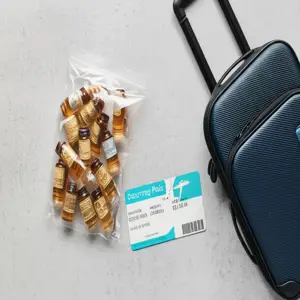
airplane travel rules
- Case Study 1: The Confiscated Duty-Free Purchase: A traveler purchased several bottles of liquor at a duty-free shop in Europe, planning to bring them home to the United States. However, they had a connecting flight in Canada. Because they opened the STEB bag to sample one of the bottles during their layover in Canada, the Canadian customs officials confiscated all the bottles, as they were no longer considered duty-free items. This highlights the importance of keeping duty-free purchases sealed until you reach your final destination country.
- Example 2: The Discreet Nip: A passenger successfully brought several nips through TSA security by packing them in their carry-on bag within the 3-1-1 rule. However, they were caught consuming one of the nips discreetly in the airplane lavatory. A flight attendant noticed and issued a warning, explaining that it was against airline policy to consume personal alcohol on board. This demonstrates that even if you successfully navigate TSA regulations, you still need to abide by airline policies.
- Case Study 3: The Overzealous Traveler: A traveler attempted to bring several large bottles of liquor in their checked baggage, exceeding the 5-liter limit. Upon arrival in their destination country, customs officials discovered the excess alcohol and imposed a hefty duty fee. The traveler had to pay a significant amount of money to reclaim their alcohol. This underscores the importance of knowing and adhering to customs regulations.
- Example 4: The Compliant Passenger: A passenger wanted to bring a special bottle of locally-made whiskey back home. He researched the duty-free allowance for his destination country (the US), ensured the bottle was properly packaged in his checked luggage, and declared it upon arrival at customs. He followed all the rules and had no issues bringing the bottle home.
These examples illustrate that successfully bringing nips on a plane requires careful planning, knowledge of regulations, and adherence to both TSA and airline policies. It’s often easier and less risky to simply purchase alcohol at your destination.
Practical Tips for Traveling with Alcohol
If you decide to travel with alcohol, here are some practical tips to help you navigate the regulations and avoid any problems:
- Research, Research, Research: Before you travel, thoroughly research the TSA regulations, airline policies, and customs regulations of your destination country and any connecting countries.
- Use Official Sources: Rely on official government websites and airline websites for the most accurate and up-to-date information. Don’t rely on hearsay or outdated information from unreliable sources.
- Pack Smart: If you’re bringing nips in your carry-on bag, make sure they comply with the 3-1-1 rule. If you’re packing alcohol in your checked baggage, ensure it’s in unopened retail packaging and that you don’t exceed the 5-liter limit.
- Declare Your Alcohol: When arriving in your destination country, declare any alcohol you’re bringing with you to customs officials. This will help you avoid any misunderstandings or penalties.
- Be Respectful and Courteous: When interacting with TSA officers, flight attendants, and customs officials, be respectful and courteous. If you have any questions or concerns, ask politely and follow their instructions.
- Consider Alternatives: Before you travel, weigh the pros and cons of bringing your own alcohol versus purchasing it at your destination. In many cases, the latter option is simpler and less risky.
- Stay Informed About Changes: Travel regulations can change frequently, so it’s important to stay informed about any updates or revisions. Check the TSA website, airline websites, and government websites for the latest information before you travel.
The Future of Alcohol Regulations in Air Travel
The landscape of alcohol regulations in air travel is constantly evolving. As airlines and aviation authorities continue to grapple with issues of safety, security, and passenger behavior, we can expect to see further changes and refinements to these regulations. Several factors are likely to influence these changes:

TSA alcohol regulations
- Increased Security Measures: In response to potential security threats, airlines and aviation authorities may implement stricter screening procedures for liquids, including alcohol. This could make it more difficult to bring alcohol in your carry-on bag.
- Crackdown on Disruptive Behavior: Following incidents of unruly passenger behavior, airlines may adopt a zero-tolerance policy towards alcohol consumption on flights. This could lead to stricter enforcement of existing policies and harsher penalties for violations.
- Technological Advancements: Advancements in technology, such as improved alcohol detection devices, could enable airlines to more effectively monitor and control alcohol consumption on board.
- Harmonization of Regulations: Efforts to harmonize alcohol regulations across different countries and regions could simplify international travel for passengers. However, achieving complete harmonization is a complex and challenging process.
- Focus on Responsible Consumption: There may be a growing emphasis on promoting responsible alcohol consumption among travelers. This could involve educational campaigns, awareness programs, and partnerships with organizations that promote responsible drinking.
Staying informed about these potential changes will be crucial for travelers who wish to bring alcohol on a plane in the future.
FAQ: Your Burning Questions Answered
Still have questions? Here are some frequently asked questions about bringing nips on a plane:
Can I bring nips in my carry-on if they are under 3.4 ounces (100ml)?
Yes, according to TSA regulations, you can bring nips in your carry-on bag if they are 3.4 ounces (100ml) or less and fit comfortably in a single, quart-sized, clear, plastic zip-top bag. However, remember that airline policies prohibit consuming your own alcohol on board.
Can I drink the nips I bring on the plane?
No, almost all airlines prohibit passengers from consuming their own alcohol on board. You are only allowed to consume alcohol that is served to you by a flight attendant. Violating this rule can result in penalties.
What happens if I get caught drinking my own alcohol on the plane?
The consequences can range from a verbal warning and confiscation of the alcohol to more severe penalties, such as a written warning, removal from the flight, or even legal charges.
Can I bring a larger bottle of alcohol in my checked baggage?
Yes, you can bring larger bottles of alcohol in your checked baggage, provided they are in unopened retail packaging, have an alcohol content between 24% and 70% ABV, and you don’t exceed the 5-liter limit per passenger. Alcohol above 70% ABV is prohibited.
What is the duty-free allowance for alcohol when traveling internationally?
The duty-free allowance for alcohol varies widely from country to country. You need to research the specific regulations of your destination country before you travel. Refer to the table above for examples.
Can I buy alcohol at a duty-free shop at the airport and bring it on my connecting flight?
Yes, but the alcohol must be placed in a Secure Tamper-Evident Bag (STEB) and remain unopened until you reach your final destination country. It also needs to comply with the carry-on restrictions of your connecting flights if it is not checked through.
What happens if I open my duty-free alcohol before arriving at my final destination?
If you open your duty-free alcohol before arriving at your final destination country, it may be confiscated by customs officials, and you may be required to pay duties and taxes.
Are there any countries where it is illegal to bring alcohol?
Some countries have very strict laws regarding alcohol importation and consumption. It’s essential to research the specific regulations of your destination country before you travel to avoid any legal issues.
What is the best way to transport expensive or rare bottles of alcohol?
If you’re transporting expensive or rare bottles of alcohol, it’s best to pack them securely in your checked baggage, using protective packaging to prevent breakage. You may also want to consider purchasing travel insurance to cover any potential loss or damage.
If I am traveling from one EU country to another, are there any restrictions on bringing alcohol?
When traveling between EU countries, you can usually bring alcohol for personal use without paying extra tax (duty or VAT) as long as you have paid tax on it in an EU country. However, customs officers may ask for proof of purchase if you are carrying large quantities.
Conclusion: Final Thoughts on Flying with Nips in 2025
So, can you bring nips on a plane in 2025? The answer, as we’ve explored, is a nuanced “it depends.” While TSA regulations may allow you to bring nips in your carry-on if they adhere to the 3-1-1 rule, and checked baggage rules offer more leeway regarding quantity, airline policies almost universally prohibit consuming your own alcohol on board. Furthermore, international travel adds the complexities of customs regulations and duty-free allowances.
Navigating these rules requires diligent research, careful planning, and a willingness to comply with the often-strict regulations. Weigh the convenience of having your own nips against the potential risks and hassles of navigating these rules. Consider the alternatives: purchasing alcohol at your destination, enjoying airline-served beverages, or exploring local bars and breweries. Consider this alternative if you’re unsure about compliance.
The trend toward stricter enforcement of alcohol policies on flights, coupled with the increasing scrutiny of unruly passenger behavior, suggests that the future of in-flight alcohol consumption may become even more regulated. It’s essential to stay informed about the latest changes and be prepared to adapt your travel plans accordingly. Remember, responsible behavior, respectful communication with airline staff, and adherence to regulations are key to ensuring a safe and enjoyable travel experience for yourself and your fellow passengers. Before heading to the airport, check the latest TSA Guidelines for any changes.
Ultimately, deciding whether to bring nips on a plane is a personal choice. However, by understanding the regulations, weighing the risks, and considering the alternatives, you can make an informed decision that aligns with your travel goals and ensures a smooth and stress-free journey. Safe travels!

